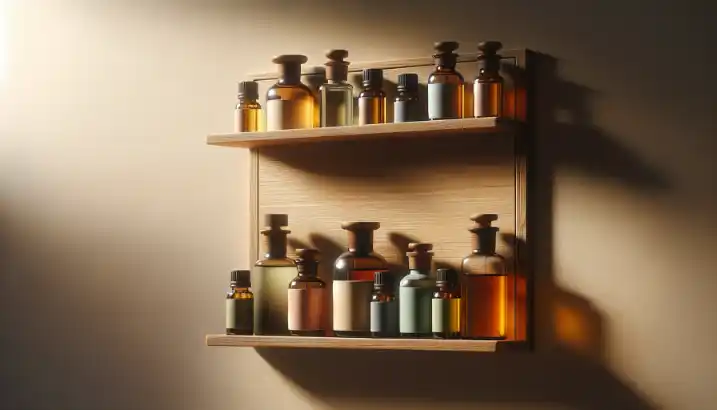Ways to Test Essential Oils at Home: Ensure Purity
Are you confident the fragrance oils you use, like lavender and patchouli, are pure and safe?
It’s vital to ensure the purity of oils used in aromatherapy and crystal healing. It’s crucial to verify the purity of oils like lavender and patchouli for safety and effectiveness.
One popular at-home method is the blotter test. In crystal healing, this test checks oil quality and its reaction with paper. By learning DIY testing methods like the blotter test, you control what enters your body.

Let’s explore approaches to confirm your lavender oils are truly pure.
Common Misconceptions about Testing Essential Oil Purity at Home
Debunking the Complexity and Accuracy Myths
There are many misconceptions surrounding the idea of testing the purity of pure lavender essential oil at home. Some people believe that it is a complex process that requires specialized equipment and extensive knowledge. However, this couldn’t be further from the truth.
In reality, there are simple tests you can perform right in your own home to get an initial assessment of purity. This research can support crystal healing practices.
Supplier Claims: Not Always Reliable
One common misconception is that relying solely on supplier claims guarantees pure essential oils. While reputable suppliers strive to provide high-quality products, it’s important to remember that not all claims may be accurate.
Some unscrupulous suppliers may mislabel or adulterate their lavender and vetiver oils, making it crucial for consumers to have a way to verify purity independently. This can be done through research and conducting a blotter test.
Simple Tests for Initial Purity Assessment
Contrary to popular belief, testing the purity of pure lavender essential oil at home doesn’t have to be complicated. There are several straightforward methods you can use to get an initial assessment of the oils you have purchased for crystal healing.
These tests don’t require any fancy equipment or extensive scientific knowledge. With these simple tests, you can ensure the care and quality of your crystals.
Here are some easy ways you can test the purity of essential oils, such as pure lavender and vetiver, at home. You can also consider using crystal healing techniques or conducting instrumental testing.
- Visual Inspection: Start by examining the appearance and consistency of the oil. Pure essential oils should be clear and free from any sediment or impurities.
- Smell Test: The aroma of essential oils can provide valuable clues about their quality and purity. Pure oils will have a strong, distinct scent characteristic of the plant they were derived from.
- Solubility Test: Many essential oils are soluble in alcohol but not in water. You can conduct a solubility test by adding a few drops of oil to both alcohol and water separately and observing how well they dissolve.
- Paper Test: This simple test involves placing a drop of oil on blotting paper or a white piece of paper and allowing it to evaporate. Pure essential oils should not leave behind any oily residue or stain.
- Refractive Index Test: While this test requires a refractometer, which is a small investment, it can provide more accurate results. The refractive index of an oil can help determine if it has been adulterated with other substances.
Step-by-Step Guide: Conducting the Paper Test to Check Essential Oil Purity
What is the paper test?
The paper test is a simple and accessible method for testing the purity of lavender essential oils at home. By observing the color, residue, and absorption patterns on a piece of paper, you can gain valuable insights into the quality of your lavender oils.

This article can help identify potential adulteration or contamination, ensuring that you are using pure and high-quality lavender essential oils for crystal healing.
How to conduct the paper test
- Gather your materials: You will need a white piece of paper (preferably unbleached), a dropper, and the lavender essential oil for crystal healing you wish to test.
- Prepare the paper: Take your white piece of paper and place it on a flat surface. Make sure there are no stains or marks on the paper that could interfere with your observations. Use your thumb to secure the lavender in place.
- Apply the lavender oil: Using a dropper, place one drop of lavender essential oil onto the center of the blotter test paper. Be careful not to use too much oil as it may spread too far and make observations difficult.
- In this article, we will discuss the blotter test for lavender essential oil. When performing the blotter test, observe any color changes that occur on the paper. Pure lavender essential oil should evaporate quickly without leaving behind any noticeable stains or discoloration. If you notice any significant color changes or staining during the blotter test, it could be an indication of impurities in your lavender oil. Crystal healing enthusiasts often use this test to assess the purity of their oils.
- Look for residue: After allowing some time for evaporation, perform a blotter test to check if there is any residue left behind on the lavender-scented paper where you initially applied the oil crystals. Pure essential oils should leave little to no residue behind, while lower-quality oils or those that have been diluted may leave visible traces.
- Assess absorption patterns with a blotter test: Another aspect to consider in this lavender article is how well the oil absorbs into the paper. Pure essential oils, like lavender, should absorb evenly without leaving patches or oily spots behind. If you notice uneven absorption patterns or greasy spots on the paper, it could suggest the presence of additives or contaminants in crystal healing practices.
- Compare healing results: To get a better understanding of the purity of your essential oil crystals, you can compare your observations with known samples of pure healing crystals. This article can help you identify any discrepancies and determine if further testing or investigation of the healing crystals is necessary.
Remember that while the paper test is a useful tool for assessing essential oil purity at home, it may not provide definitive results for crystals. For more accurate and detailed analysis of healing properties, professional laboratory testing is recommended as the next step.
The Significance of Organoleptic Evaluation in Determining Essential Oil Purity
What is Organoleptic Evaluation?
Organoleptic evaluation, also known as sensory evaluation, is a method used to assess the healing quality and purity of essential oils based on their sensory characteristics. This approach relies on our senses of smell, sight, touch, and taste to determine the overall healing quality of an essential oil.
Understanding Aroma, Appearance, Consistency, and Taste
When evaluating essential oil quality, there are several key factors to consider: aroma, appearance, consistency, taste, and the essential oil blotter test.
Aroma
The scent of an essential oil is one of the most important indicators of its quality. Pure essential oils should have a strong and distinct aroma that accurately represents the plant from which it was extracted.
If an essential oil has a weak or synthetic smell, it may be an indication of impurities or adulteration.
Appearance
The color and clarity of an essential oil can provide valuable insights into its purity. Generally, pure essential oils have a clear appearance with little to no sediment or cloudiness. However, some oils naturally have a slightly yellow or amber hue due to their botanical origins.
Any drastic changes in color or the presence of visible particles may suggest contamination.
Consistency
The consistency or viscosity of an essential oil can vary depending on its chemical composition and extraction method. While some oils are thin and watery in texture (e.g., citrus oils), others are thicker and more viscous (e.g., patchouli).

It’s crucial to familiarize yourself with the typical consistency of different oils so that you can identify any abnormalities that might indicate impurities.
Taste
Tasting essential oils should only be done by experienced individuals who understand safety precautions associated with ingestion. Ingestion should never be attempted without proper guidance from a qualified professional.
Performing Organoleptic Evaluations at Home
Now that you understand the significance of organoleptic evaluation in determining essential oil purity, let’s explore some tips on how to perform these assessments accurately at home.
- Create a controlled environment: Find a quiet and well-ventilated space where you can concentrate on evaluating the oils without any distractions or strong odors interfering with your senses.
- Familiarize yourself with reference samples: Obtain high-quality, pure essential oils from reputable sources to use as reference samples for comparison. These reference samples will help you develop a baseline understanding of what pure oils should look, smell, and feel like.
- Use appropriate containers: When evaluating essential oils, it’s important to use clean glass containers or test strips specifically designed for this purpose. Avoid using plastic or metal containers as they may interact with the oil and affect its aroma or appearance.
- Assess aroma through sniffing: Open each bottle of essential oil and take a moment to inhale deeply. Pay attention to the intensity, complexity, and overall quality of the scent. Compare it to your reference samples to identify any discrepancies.
Key Considerations for Home Testing of Essential Oil Purity
Factors That Affect Essential Oil Purity Over Time
It’s important to consider various factors that can affect their quality over time. One crucial factor is the storage conditions. Essential oils should be stored in dark glass bottles, away from direct sunlight and extreme temperatures.
Exposure to light and heat can cause oxidation, leading to a decline in oil purity.
Another consideration is the shelf life of essential oils. Different oils have varying shelf lives, which can range from one to five years or more. It’s essential to check the manufacturing date or batch number on the bottle and keep track of how long you’ve had the oil. As oils age, they may lose their potency and purity, making regular testing even more important.
The Importance of Sourcing High-Quality Oils
To ensure accurate tests for essential oil purity, sourcing high-quality oils from trusted suppliers is paramount. Not all essential oils are created equal, and some unscrupulous manufacturers may dilute or adulterate their products with synthetic additives or lower-quality ingredients.

Trusted suppliers often provide detailed information about their sourcing methods, including where the plants for essential oil quality are grown and how they are harvested. Look for suppliers who use organic farming practices and conduct rigorous testing themselves before selling their essential oil quality products.
Consistency in Testing Methods
Maintaining consistency in your testing methods is crucial when tracking changes in oil quality over time. By using consistent procedures each time you test an oil sample, you’ll be able to compare results accurately and identify any variations or trends.
Monitoring Pesticide Residue: In-House Testing for Safer Essential Oils
The Dangers of Pesticide Residue in Essential Oils
Pesticide residue in essential oils can pose serious health risks. These harmful chemicals are often used during the cultivation process to protect plants from pests and diseases. However, when these pesticides make their way into essential oils, they can become concentrated and potentially toxic.
To ensure the safety of your essential oils, it is crucial to be aware of the potential risks associated with pesticide residue. By understanding these dangers, you can take proactive steps to protect yourself and your loved ones.
Simple Methods for Testing Pesticide Contamination at Home
Fortunately, there are several straightforward methods you can use to test the purity of essential oils for pesticide contamination right in the comfort of your own home. These methods allow you to have greater control over the quality of the oils you use.
- Sniff Test: Start by smelling the oil. If it has a strong chemical or synthetic odor, it may indicate the presence of pesticides. Pure essential oils should have a natural and pleasant aroma that reflects their plant origins.
- Refractive Index: Each essential oil has a unique refractive index value that can help determine its purity. You can purchase a refractometer specifically designed for testing essential oils or consult a professional lab to measure this value accurately.
- Research Brands: Do thorough research on different brands before making a purchase. Look for companies that prioritize organic or responsibly sourced ingredients and follow strict quality control measures.
- Label Examination: Carefully read the label on the bottle of essential oil you intend to buy or currently own. Look out for any indications that it is certified organic or free from pesticides.
- Grease Test: Apply a small amount of carrier oil (such as apricot kernel oil) onto a clean glass surface and add a drop of the essential oil you want to test. If the oil spreads quickly and leaves a greasy residue, it may contain additives or pesticides. Pure essential oils should evaporate without leaving behind a greasy film.
- Rotation Method: Use different brands and varieties of essential oils in rotation rather than sticking to just one brand. This helps minimize the risk of prolonged exposure to any potential pesticide residues.
The Importance of Choosing Organic or Responsibly Sourced Oils
Opting for organic or responsibly sourced options is crucial for minimizing pesticide contamination. These oils are derived from plants that have been cultivated without the use of synthetic pesticides, making them safer for use.

By choosing organic or responsibly sourced oils, you not only protect yourself from potential health hazards but also support sustainable farming practices that prioritize environmental preservation.
Conclusion: Empowering Home Testing for Pure and Safe Essential Oils
In conclusion, testing the purity of essential oils at home is not only possible but also crucial for ensuring your safety and well-being. By debunking common misconceptions and providing step-by-step guidance, we have shown that anyone can conduct simple tests to assess the quality of their oils.
By taking control of the quality assessment process at home, you become empowered as a consumer. You gain confidence in selecting pure and safe essential oils that align with your personal needs and preferences.
Remember,Trust your instincts while relying on reliable information. Take charge of your well-being by embracing these testing methods that empower you with knowledge about the products you use every day.
FAQs
What are some signs that indicate impurity in essential oils?
Signs of impurity in essential oils may include an unusual smell or inconsistency in texture compared to what is expected for that particular oil. If the oil causes skin irritation or adverse reactions when used as directed, it may be an indication of impurity.
Can I trust essential oil suppliers who claim their oils are pure?
While many suppliers claim to provide pure essential oils, it is important to exercise caution and do your research. Look for suppliers who provide transparency about their sourcing methods, third-party testing, and certifications from reputable organizations.
Are there any home tests that can detect synthetic additives in essential oils?
Home tests may not specifically detect synthetic additives in essential oils. However, conducting a thorough assessment of aroma, consistency, and potential adulterants through methods like the paper test and organoleptic evaluation can help identify any inconsistencies that might indicate the presence of additives or impurities.
How often should I perform purity tests on my essential oils?
The frequency of purity tests depends on various factors such as the shelf life of the oil and its intended use. As a general guideline, consider performing tests periodically or whenever you purchase new batches of essential oils to ensure consistent quality over time.
Can I rely solely on home testing methods for accurate results?
While home testing methods provide valuable insights into essential oil purity, they may have limitations. For more accurate and comprehensive results, incorporating third-party testing by reputable laboratories can offer additional assurance regarding the quality and authenticity of your essential oils.
